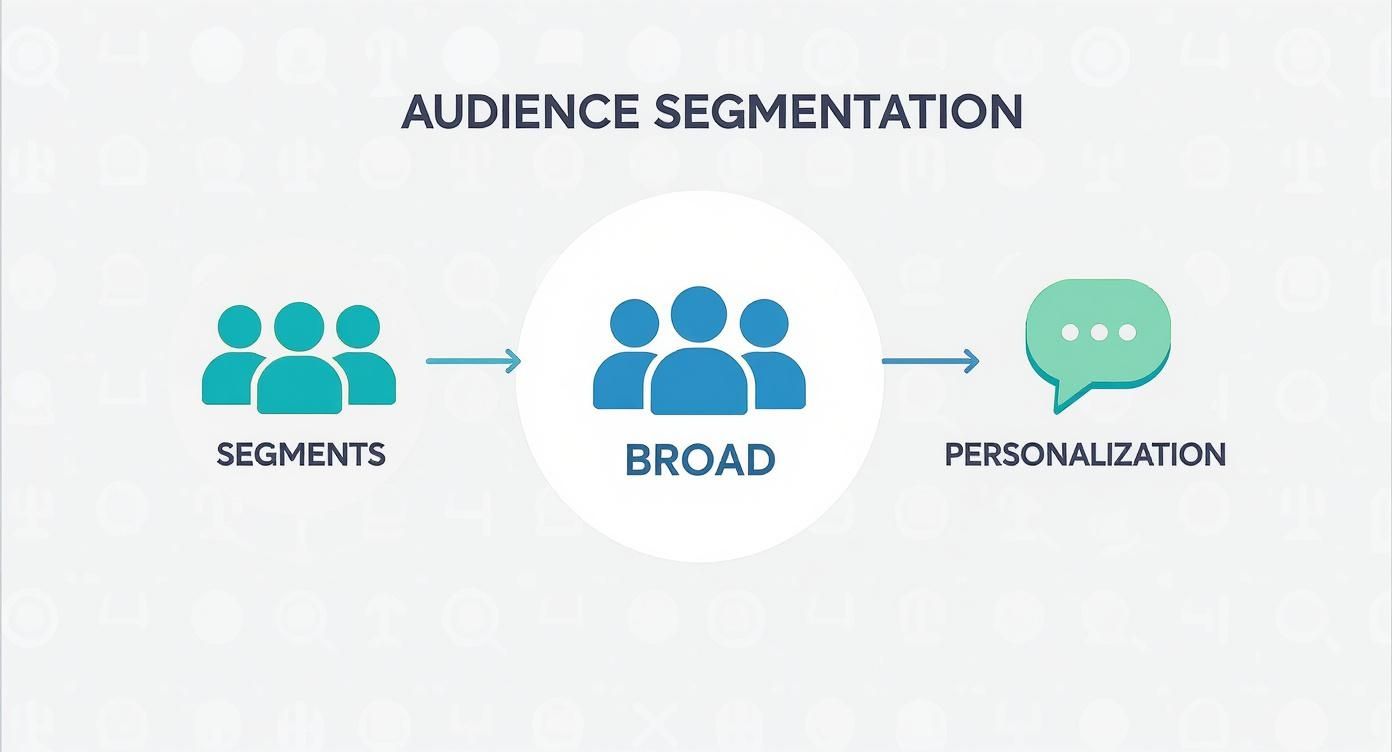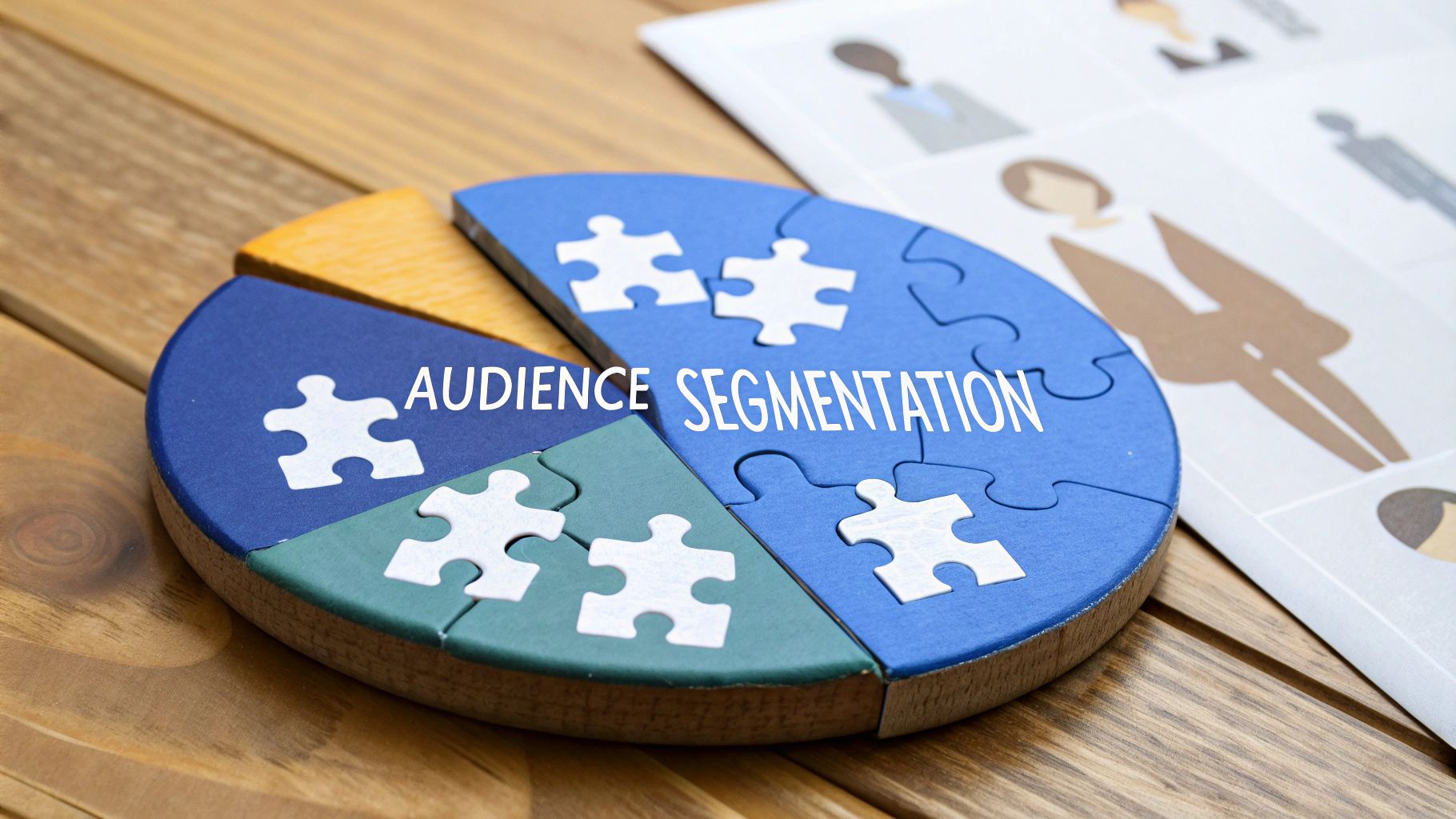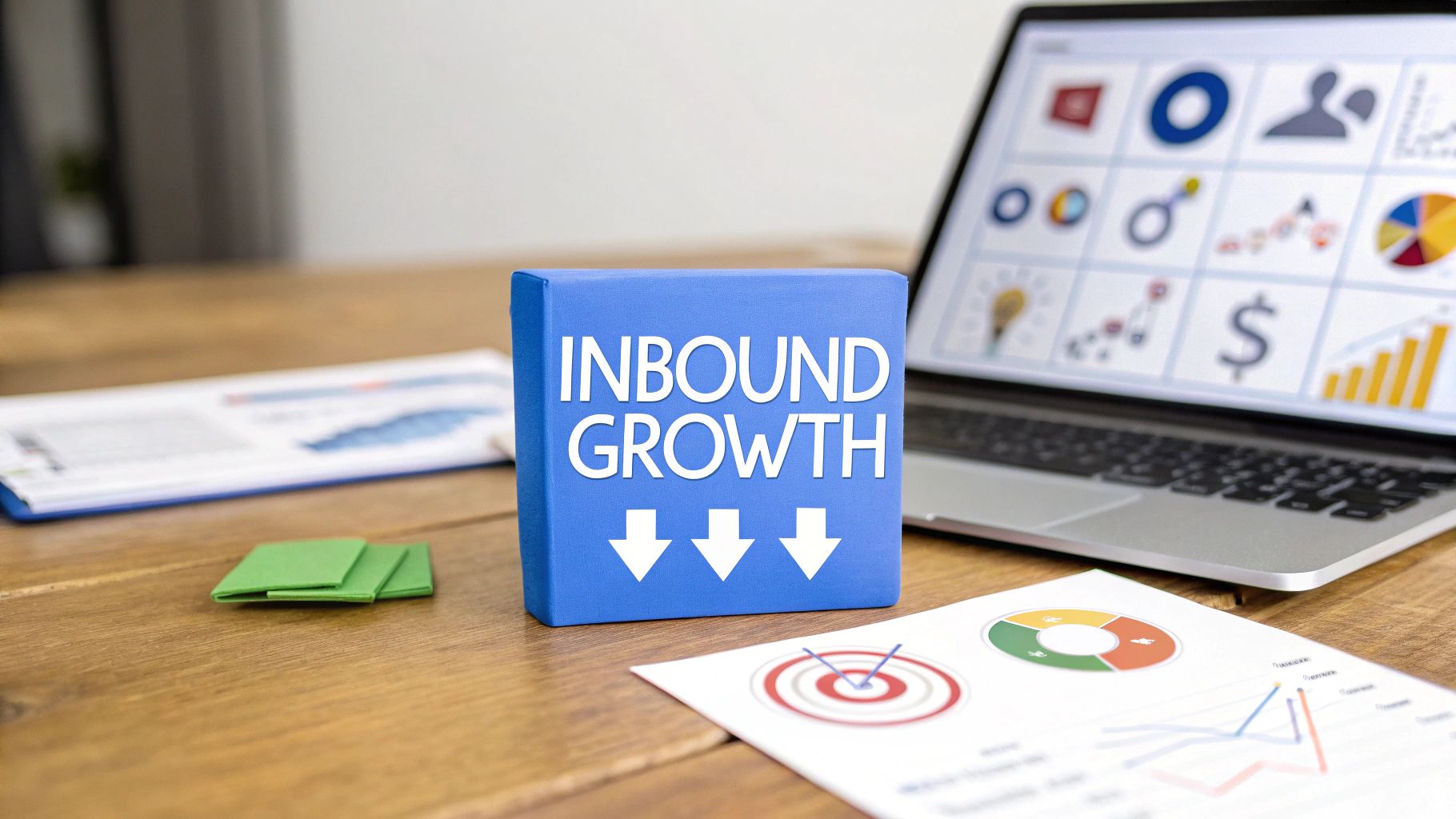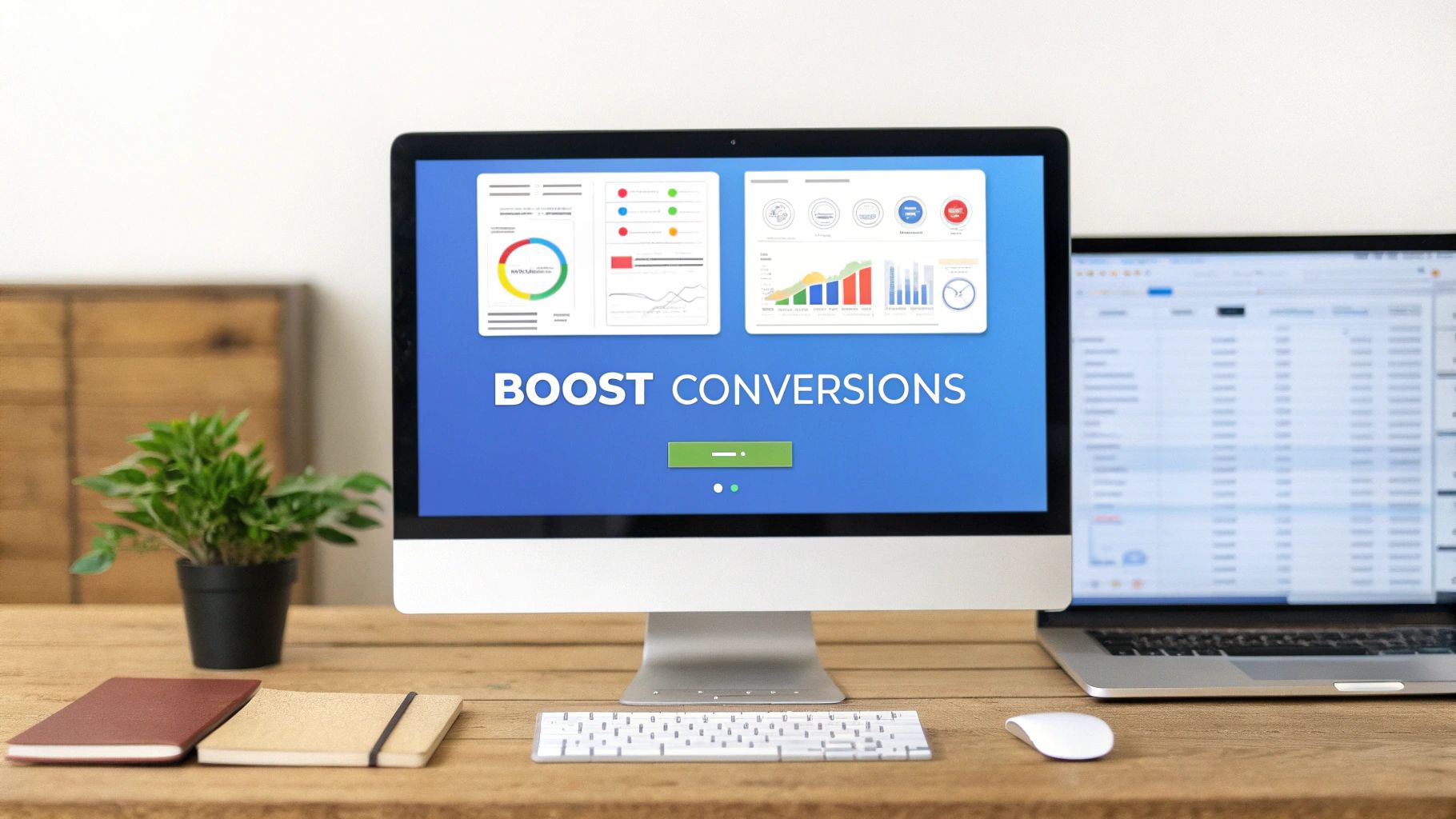Summary
Meta Description: Wondering what is audience segmentation? This guide breaks down the four core types, how to apply them, and how they unlock measurable business growth. Start connecting today.
Audience segmentation is a powerful strategy for moving beyond generic marketing. Instead of speaking to your entire customer base as a single, faceless crowd, you divide them into smaller, more manageable groups based on shared characteristics. This simple shift allows you to stop shouting a generic message and start having meaningful conversations that genuinely connect with specific customer needs.
Why You Should Stop Marketing to Everyone and Start Connecting
Imagine a librarian throwing every book into one massive, disorganized pile. Finding what you need would be a nightmare, right? That's what marketing feels like to your customers when you lack a clear segmentation strategy. You're essentially yelling into the void, hoping someone out there is listening.
Segmentation helps you get smarter. It's built on the fundamental truth that your customer base isn't a single entity. It's a collection of real people with different problems, unique desires, and varied reasons for being interested in what you offer. When you group them based on these shared traits, you can tailor everything—your products, your ads, your landing pages—to what they truly care about.
Are you ready to make your marketing more effective?
How This Shift Directly Impacts Your Growth
Moving from a "spray-and-pray" approach to a segmented one isn't just a trendy tactic; it's a foundational pillar of modern, successful businesses. This isn't just theory—it has a direct, measurable impact on your bottom line, and the proof is in the data.
The entire industry built around understanding audiences is exploding. For example, the global audience analytics market—the engine powering effective segmentation—was valued at around $5 billion and is projected to nearly double to $10 billion by 2030. This highlights a massive pivot in how companies are choosing to build customer relationships. You can dive deeper into the growth of audience analytics and its market trends at Grand View Research.
Audience segmentation transforms marketing from a monologue into a dialogue. It’s the difference between sending a bulk email blast and sending a personalized note that says, "We know what you need, and we're here to help."
Ultimately, this strategy helps you achieve three critical outcomes:
- Build Stronger Relationships: When your messaging is relevant, customers feel seen and understood. That feeling builds loyalty and trust faster than any generic campaign.
- Improve Marketing ROI: You stop wasting money on people who were never going to be interested. Instead, you focus your resources on the groups most likely to convert, naturally boosting your return.
- Drive Better Results: Personalized experiences lead to more clicks, more sign-ups, and more sales. It's the engine for sustainable, long-term growth.
The Four Core Types of Audience Segmentation Explained
Once you realize you need to stop shouting your message at everyone, the next question is clear: how do you group people effectively? Breaking down your audience into smaller, specific segments can feel daunting, but it boils down to four fundamental methods. These are the building blocks of nearly all successful segmentation strategies.
Each type answers a different, crucial question about your customers. By combining them, you can move from a blurry, wide-angle shot of your audience to a collection of crystal-clear portraits.
This infographic breaks down the journey from a broad audience to targeted, personalized messaging through segmentation.

As the visual shows, the goal is to filter a large crowd into distinct groups. This lets you craft messages that connect on a personal level.
To help you grasp these concepts, let's break them down. Think of it as moving from the basic "who" and "where" to the more powerful "why" and "what."
Comparing the Four Main Types of Audience Segmentation
This table provides a quick, at-a-glance comparison of the four core segmentation types. It outlines what each one measures, the kind of data you'd examine, and a practical business example to see it in action.
Understanding these distinctions is the first step. When you can see your audience through these four lenses, you start to spot opportunities you might have missed before.
1. Demographic Segmentation: The "Who" of Your Audience
Demographic segmentation is often the first stop for marketers, and for good reason. It’s straightforward, grouping people based on objective, statistical data. Think of it as the foundational "who" of your audience. This information is relatively easy to find and provides a solid basis for more detailed analysis.
Common demographic data points include:
- Age: You wouldn't market a new gaming console to a 65-year-old in the same way you would to a teenager.
- Gender: A skincare brand might create different campaigns for its male and female product lines.
- Income Level: A budget airline focuses on price-sensitive travelers, while a private jet company targets high-net-worth individuals.
- Occupation or Education: A B2B software company might target marketing managers at tech companies with specific messaging.
2. Geographic Segmentation: The "Where" of Your Audience
Just as the name suggests, geographic segmentation organizes your audience based on their location in the world. This can be as broad as a country or as specific as a single zip code. It's powerful because a person's location often heavily influences their culture, needs, and buying habits.
A classic example? A clothing retailer would promote heavy winter coats to customers in colder northern climates while simultaneously marketing swimsuits to those in sunny, southern regions. Simple, but incredibly effective.
3. Psychographic Segmentation: The "Why" Behind the Buy
Now, this is where things get really interesting. Psychographic segmentation moves beyond the "who" and "where" to explore the "why." It groups people based on their psychological traits—like their lifestyle, values, interests, and attitudes. This is the data that helps you understand what truly motivates your customers.
A sportswear brand might use psychographics to distinguish between two segments: the "Weekend Warrior" who values adventure and exploration, and the "Home Gym Hero" who prioritizes convenience and consistency. Though their demographics might be identical, their motivations are worlds apart.
4. Behavioral Segmentation: The "What" of Their Actions
Finally, we have behavioral segmentation. This method divides your audience based on their direct actions and interactions with your brand. This is one of the most effective types because it’s based on proven behavior, not just assumptions. It tells you exactly how people use your product or engage with your marketing.
Common behavioral data includes:
- Purchase History: Targeting frequent buyers with an exclusive loyalty program.
- Engagement Level: Sending a re-engagement campaign to users who haven't logged into your app for 30 days.
- Benefits Sought: Grouping customers who always use "free shipping" coupons versus those who prioritize next-day delivery.
Understanding how users interact with your brand is a critical piece of the marketing puzzle. For a deeper dive into this specific method, learn more about what is behavioral targeting in our detailed guide.
How Segmentation Unlocks Measurable Business Growth
Putting in the effort to properly segment your audience isn't just a marketing exercise—it translates directly into tangible business results. Instead of shouting a one-size-fits-all message, segmentation lets you create specific experiences that make customers feel seen and understood. That's how you build the strong relationships that form the bedrock of sustainable growth.
Think about it. When your marketing speaks directly to a person's needs or interests, it immediately cuts through the digital noise. This focused approach is not only more effective but also far more efficient. You stop burning cash on audiences who were never going to convert and start concentrating resources where they'll make an impact. This is how you turn your marketing spend from a gamble into a predictable engine for growth.
The numbers don't lie. For instance, 81% of consumers are more likely to buy from brands that offer personalized experiences. Companies that nail their segmentation have seen a mind-blowing 760% increase in email marketing revenue. To top it off, targeted marketing programs generate about 77% of a campaign's overall ROI. You can dig into even more data on audience segmentation strategy at Britopian.
How to Boost Customer Loyalty and Lifetime Value
One of the biggest wins from a smart segmentation strategy is its direct impact on customer retention. When your campaigns are relevant and valuable, customers stay engaged and are far more likely to become repeat buyers. This consistent, positive interaction builds a powerful sense of loyalty that competitors will find incredibly difficult to break.
By understanding what different customer groups actually value, you can create tailored loyalty programs, exclusive offers, and content that reinforces their decision to choose your brand. This is how you turn one-time buyers into long-term advocates.
This is a huge deal because retaining an existing customer is significantly cheaper than acquiring a new one. A well-executed segmentation plan is one of the most powerful tools for improving customer lifetime value. It ensures your business grows not just by chasing new leads, but by nurturing the fantastic customers you already have.
How to Maximize Your Marketing Return on Investment
At the end of the day, every marketing dollar has to pull its weight. Audience segmentation provides a clear roadmap to maximizing your return on investment (ROI) by ensuring your budget is spent as intelligently as possible.
How does this look in the real world?
- Smarter Ad Spend: You can push more of your budget toward high-converting segments and pull back from those with low engagement, optimizing ad performance on the fly.
- Higher Conversion Rates: Because your landing pages, ads, and emails are tailored to specific needs, they simply work better. They resonate more strongly and drive more action.
- Reduced Waste: You stop throwing money away by marketing to people who have zero interest in what you're selling—a classic pitfall of broad, unsegmented campaigns.
This focused approach means every dollar you spend has a much higher potential for return, making your entire marketing machine more efficient and effective.
How to Put Audience Segmentation Into Practice
Knowing the theory is one thing, but putting it into action is where you'll see real results. Getting started with an audience segmentation strategy can feel like a huge task, but it doesn't have to be. The key is to start small, prove the concept for your business, and then scale up as you learn what resonates.

The trick is to avoid getting overwhelmed. Instead of trying to map out a dozen perfect segments right away, focus on one or two high-value groups first. This approach keeps things manageable and helps you sidestep common pitfalls.
Step 1: Start with Clear Business Objectives
Before you even touch a spreadsheet, ask yourself: what am I trying to achieve? What business goal will segmentation help me reach? Perhaps you want to boost customer loyalty, drive more sales for a specific product, or simply get more from your ad spend.
Having a clear objective is like a North Star for your strategy. For example, an e-commerce brand could set a goal to "reduce cart abandonment by 15%" by targeting people who leave items behind with a personalized follow-up campaign. This clarity makes every other step in the process much simpler.
Step 2: Gather and Analyze the Right Customer Data
Once you have a goal, it's time to dig into the data that will help you find your key segments. You don't need a massive, complex data warehouse to get started. Just begin with what you already have.
Here are a few great places to look for insights:
- Website Analytics: Tools like Google Analytics are packed with behavioral data. You can see which pages people visit, how long they stay, and what actions they take.
- Customer Surveys: Sometimes, the easiest way to understand your audience is to just ask them. Surveys can uncover psychographic gold, like their motivations, interests, and biggest pain points.
- CRM Data: Your Customer Relationship Management system is a treasure trove of demographic info and purchase histories.
- Social Media Insights: Platforms like Instagram and Facebook offer analytics that reveal a lot about your followers' demographics and interests.
Iconic brands like Spotify are masters of this. They use behavioral data—what you listen to, when you listen, and what you skip—to create incredibly personal experiences like the "Discover Weekly" playlist. They've turned data into a feature their customers absolutely love.
Step 3: Build and Prioritize Your Key Segments
With your data in front of you, start looking for patterns. Group customers together who share common traits relevant to your objective. For instance, you could create segments like "First-Time Buyers," "High-Value Repeat Customers," or "Inactive Subscribers."
Don't try to target everyone at once. Prioritize one or two segments that offer the biggest potential impact on your goal. A great place to start is often with your most loyal customers or with a group showing strong signs they're ready to buy. For practical strategies, check out these insights on how to effectively market to different segments and demographics.
This focused approach lets you test your strategy on a smaller, more manageable scale. You can take what you learn and roll it out to other segments over time. Aligning your marketing messages with these groups is crucial, and it's a core part of how dynamic content can improve your SEO, too.
What is the Future of Audience Segmentation? AI and Automation
While traditional methods provide a solid foundation, the next frontier in segmentation is already here—and it's driven by Artificial Intelligence. AI and machine learning are completely changing the game by moving beyond static, manually created audience groups. Instead of just looking at past behaviors, AI looks ahead, creating dynamic, predictive segments that shift and adapt in real time.

This evolution unlocks a level of hyper-personalization that was once science fiction. AI algorithms can sift through mountains of complex data, spotting subtle patterns in customer behavior that a human analyst would almost certainly miss. It's the difference between knowing who your customers are and predicting who they are about to become.
Using Predictive Modeling for Hyper-Personalization
AI-powered tools don't just categorize people; they build predictive models that can forecast what customers will do next. Think of it as knowing their likelihood to buy, churn, or try a new product before they even do.
This capability is a game-changer. The global AI market is expected to explode at a compound annual growth rate of 35.9% between 2025 and 2030, with marketing solutions leading the charge. These tools are becoming incredibly adept at predictive modeling and serving hyper-personalized messages that build real customer loyalty.
Imagine an e-commerce site that doesn't just see you as a "frequent shopper." Based on a few recent searches, its AI model predicts you're about to take up running. Instantly, it drops you into a "prospective runner" segment, and the content you see—from ads to product recommendations—changes to match that new identity.
Ethical Responsibilities in the Age of AI
Of course, this incredible power comes with a heavy dose of ethical responsibility. As we dig deeper into customer data to build these detailed segments, we must be serious about data privacy and transparency. It's non-negotiable.
Using AI in segmentation isn't just a technical upgrade; it's a strategic one that requires a commitment to ethical data handling. Customers must trust that their information is being used responsibly to enhance their experience, not to exploit it.
If you're ready to get started, a good guide on how to implement AI in your business can give you the practical steps you need. By embracing these advancements the right way, you can future-proof your marketing and gain a serious competitive edge.
Common Questions About Audience Segmentation
Even with a solid strategy, a few questions often pop up. Let's clear the air on some of the most common ones.
What Is the Difference Between Segmentation and Targeting?
It’s easy to mix these two up, but they are two sides of the same coin. Think of it as a simple two-step process.
Segmentation is the discovery phase. You’re looking at your entire market and dividing it into distinct groups based on shared characteristics. Imagine you’re a cartographer drawing a map—you’re not deciding where to go yet, just labeling all the different neighborhoods.
Targeting is the action phase. Now that your map is drawn, you decide which of those neighborhoods you're going to visit. You pick the specific groups where your message will resonate most and focus your marketing efforts there. First, you segment the whole map; then, you target your destinations.
How Many Segments Should I Create?
There's no magic number, but the golden rule is to start small and stay focused. Don't try to boil the ocean. It’s far more effective to start with two to four core segments that represent your most valuable or highest-potential customers.
The goal is quality over quantity. Serving a few segments exceptionally well will always beat creating dozens of vague or unmanageable ones.
This approach lets you test your messaging, measure what’s working, and scale your efforts without getting overwhelmed. Once you’ve mastered those first few segments, you can confidently expand from there.
What Are the Best Tools for Audience Segmentation?
The right tool depends on your needs and budget, but the good news is you don’t have to break the bank to get started. There are fantastic options at every level.
Google Analytics: This is your free, powerhouse starting point. It’s packed with essential behavioral and demographic data pulled directly from your website traffic, giving you a clear picture of who’s visiting your site.
Email Marketing Platforms: Tools like Mailchimp have user-friendly segmentation features built right in. You can easily group your subscriber lists based on how they engage with your emails, what they’ve clicked on, and more.
Customer Relationship Management (CRM) Systems: As you scale, a CRM like HubSpot becomes invaluable. It centralizes all your customer data, offering advanced segmentation that aligns both your sales and marketing teams.
Ready to turn your carefully crafted audience segments into landing pages that convert? LanderMagic lets you build dynamic pages that automatically adapt to each visitor's keywords, location, and behavior. Stop sending valuable traffic to a one-size-fits-all page and start delivering the personalized experience that drives real results.









